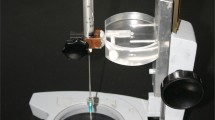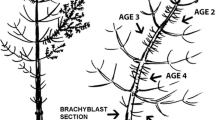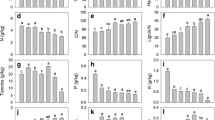Summary
Larvae of the spruce sawfly Gilpinia hercyniae were reared on whole branches of Norway spruce, Picea abies. Top and low branches were selected from flowering and nonflowring stands. Sawfly performance from the larval L2-stage until the fertile egg stage of the next generation was recorded. Growth and development were best on top branches from the flowering stand, poorest on branches from windblown, partly derooted and heavily flowering trees. Analysis of some 30 biochemicals in needles and faeces was performed. New needles had the highest concentrations of some nutrients (total nitrogen, amino acids), however, G. hercyniae larvae only fed on old needles, a 100% mortality being recorded on newly flushed needles, probably because these needles also contained the highest concentrations of the secondary compound, quinic acid. Old needles showed high variability in concentrations of nutrients and secondary compounds. Regression analysis demonstrated that the total amount of carbohydrates (glucose, fructose and sucrose) was significantly correlated with the larval linear growth rate, the maximal larval weight, the cocoon weight and the number of eggs per female. In these performance variables 72–88% of the variation could be explained by five biochemicals. Survival rates of larvae or pupae and the instantaneous growth rate could not be explained by the biochemical variables. Only weak correlations were found between nitrogen or amino acids and performance variables. Assimilation of the various biochemicals was calculated and showed high rates (90–97%) in hexoses and lower rates (38–65%) in total nitrogen and amino acids.
Similar content being viewed by others
References
Albert PJ, Cearley C, Hanson F, Parisella S (1982) Feeding responses of eastern spruce budworm larvae to sucrose and other carbohydrates. J Chem Ecol 8:233–239
Bombosch S, Ramakers PMJ (1976) Zur Dauerzucht von Gilpinia hercyniae. Z Pflanzenkr Pflanzenschutz 83:40–44
Coley PD, Bryant JB, Chapin FS (1985) Resource availability and plant antiherbivore defense. Science 230:895–899
Fogal WH (1974) Nutritive value of pine foliage for some diprionid sawflies. Proc Entomol Soc Ont 105:101–118
Harvey GT (1974) Nutritional studies of eastern spruce budworm. I. Soluble sugars. Can Entomol 106:353–365
Haukioja E (1980) On the role of plant defenses in the fluctuation of herbivore populations. Oikos 35:202–213
House HL (1974) Nutrition. In: Rockstein M (ed) The physiology of Insecta, vol 5. pp 1–62
Jensen TS (1985) Outbreak and latency populations of the nun moth Lymantria monacha. Mitt Dtsch Ges Allg Angew Entomol 4:240–243
Larsson S, Tenow O (1979) Utilisation of dry matter and bioelements in larvae of Neodiprion sertifer feeding on Scots pine. Oecologia (Berlin) 43:157–172
Lunderstädt J, Reymers A (1980) Wechselwirkung zwischen Proteinen und Phenolen nach Verfütterung von Nadeln der Fichte an Larven von Gilpinia hercyniae. Z Angew Entomol 90:113–126
Ma WQ (1972) Dynamics of feeding responses in Pieris brassica as a function of chemosensory input. Meded Landbouwhogesch Wageningen 72:1–162
Mattson WJ (1980) Herbivory in relation to plant nitrogen content. Annu Rev Ecol Syst 11:119–161
McLaughlin BM (1986) Performance of the spruce budworm (Choristoneura fumiferana) in relation to dietary and foliar levels of sugar and nitrogen. Unpubl thesis Michigan State Univ, p 1–86
Otto D (1970) Zur Bedeutung des Zuckergehaltes der Nahrung für die Entwicklung nadelfressender Kieferninsekten. Arch Forstwes 19:135–150
Rhoades D (1979) Evolution of plant chemical defense against herbivores. In: Rosenthal GA, Janzen DH (eds) Herbivores: their interrelationships with plant secondary constituents. pp 3–54
Schoonhoven LM (1986) What makes a caterpillar eat? The sensory code underlying feeding behaviour. In: Bernays E, Chapman RF, Stoffolan J (eds) Perspectives in chemoreception and behaviour. pp 69–97
Schopf R (1981) Quantitative Untersuchungen zur Nahrungsaufnahme und-ausnutzung der Blattwespe Gilpinia hercyniae. Z Angew Entomol 92:137–149
Schopf R (1986) The effect of secondary needle compounds on the development of phytophagous insects. For Ecol Man 15:55–64
Schwenke W (1963) Über die Beziehung zwischen dem Wasserhaushalt von Bäumen und der Vermehrung blattfressender Insekten. Z Angew Entomol 51:371–376
Scriber JM (1984) Host plant suitability. In: Bell WJ, Cardé RT (eds) Chemical ecology of insects. pp 159–202
Shaw GG, Little CHA, Dursan DJ (1978) Effect of fertilization of balsam fir trees on spruce budworm nutrition and development. Can J For Res 8:364–374
Slansky F, Scriber JM (1985) Food consumption and utilization. In: Kerkut GA, Gilbert LI (eds) Comprehensive insect physiology, biochemistry and pharmacology, vol 4. pp 87–163
Städler E (1984) Contact chemoreception. In: Bell WJ, Cardé RT (eds) Chemical ecology. pp 3–35
Thorvaldsson G (1987) The effects of weather on nutritional value of timothy in northern Sweden. Acta Agric Scand 37:305–319
Visser JH (1986) Host odour perception in phytophagous insects. Annu Rev Entomol 31:121–144
White TCR (1984) The abundance of invertebrate herbivores in relation to the availability of nitrogen in stressed food plants. Oecologia (Berlin) 63:90–105
Whitham TG (1983) Host manipulation of parasites: Within-plant variation as a defense against rapidly evolving pests. In: Denno RF, McClure MS (eds) Variable plants and herbivores in natural and managed systems. pp 15–41
Author information
Authors and Affiliations
Rights and permissions
About this article
Cite this article
Jensen, T.S. Variability of Norway spruce (Picea abies L.) needles; performance of spruce sawflies (Gilpinia hercyniae Htg.). Oecologia 77, 313–320 (1988). https://doi.org/10.1007/BF00378036
Received:
Issue Date:
DOI: https://doi.org/10.1007/BF00378036




